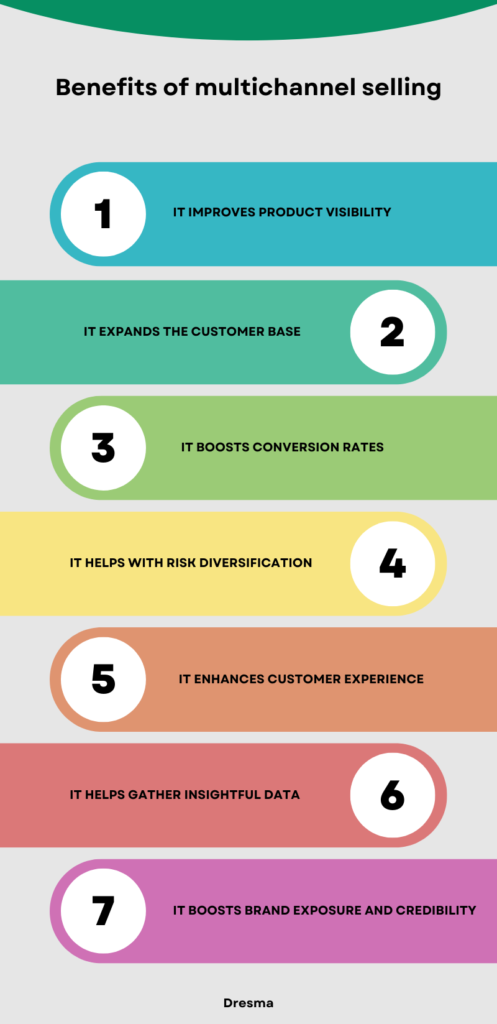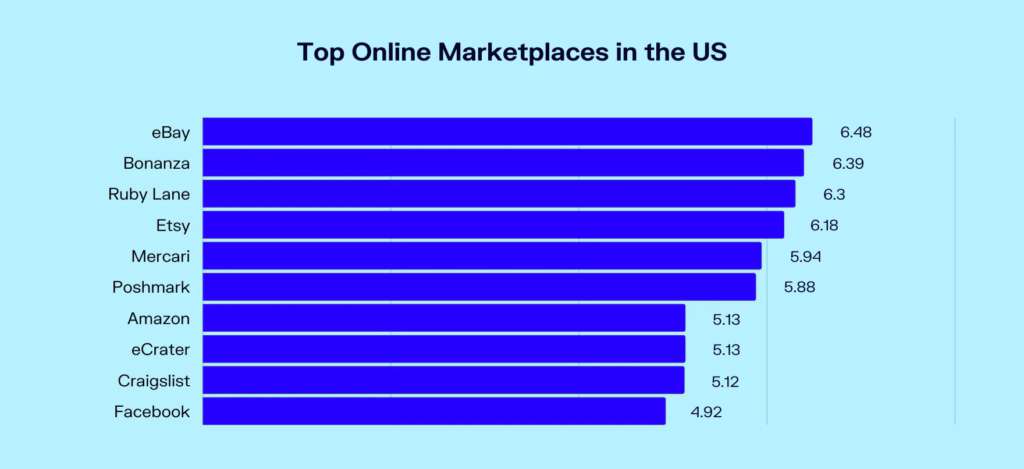
7 Best Tips to Ace Multichannel Selling
Having a single sales channel might have been the norm a few years back. But it’s safe to say that those days are over. A modern-day shopper rarely shops from a single channel any more. Therefore, retailers need to be agile and flexible in terms of choosing where to sell their products.
As an online seller, you want visitors coming to your site. But if your products are not showing up where the customers are, then you are losing out on a big chunk of business.
That is why multichannel selling is slowly becoming the norm. It is the practice of selling goods on multiple sales channels at once. It may include selling on not just your own website but also on other online marketplaces and even brick-and-mortar stores as well.
As per Statista, eCommerce sales in the US through multichannel sales are expected to reach $575 billion by 2023.
So, if you want to make the most out of multichannel selling then this article is for you. Here we are going to talk about the 7 best tips to ace multichannel selling.
But first, let’s discuss some of its key benefits.
Benefits of multichannel selling
Here are some of the key benefits of multichannel eCommerce –

7 best tips to succeed in multichannel selling
Here are a few best tips to help you win multichannel selling –
1. Find the right channels for your business
Selling on multiple channels doesn’t mean listing your products anywhere and everywhere just for the sake of it. You should choose a few sales channels that are relevant to your business. The channels you choose to sell your products on should be in sync with your business goals.
Make sure to research each channel before listing. Ask yourself the following questions –
- How much do I understand this channel?
- How much value will it create for my customers?
- Are my ideal customers going to use this sales channel?
- Where do my potential customers shop?
Based on your research, make a list of the strengths and weaknesses of each channel that you are considering.
Take the following example – If you are into B2C selling then consider using social media channels like Facebook and Instagram because these have a higher commercial user base.
On the other hand, if you are into B2B selling then professional websites like LinkedIn or B2B marketplaces like Amazon Business, HKTDC, DH Gate, Alibaba, etc. might be right for you.
A great way of finding the right channel is to ask your customers directly. This can be done by sharing questionnaires with your customers to understand their preferences.
Another great strategy is studying the channels your competitors are using.
2. Ensure a smooth inventory management
One of the biggest challenges you’ll face with multichannel selling is managing the inventory.
An organized inventory will be key to a successful multichannel eCommerce strategy. So, you must ensure that you update your product’s availability and prices on all your channels.

A few things you can do to ensure smooth inventory management –
- Try using the same inventory pool across multiple sales channels
- Sync your inventory across all sales channels, ideally every 2-5 minutes. This would enable you to relay accurate and real-time inventory levels
- Keep a track of inventory to maintain optimum levels and avoid under-stocking
- Timely restock your inventory by ensuring regular replenishment
3. Be consistent with your content
Another thing to keep in mind to succeed in multichannel selling is to use consistent content across all channels. In other words, you need to post regular content consistently through all your sales channels.
This would not only keep customers on all platforms hooked to your brand but also help them move ahead in their customer lifecycle.
This can be done in the following ways –
- Leverage user-generated content (UGC)
- Use influencer marketing to promote your products
- Connect with customers using direct messages
- Use high-quality product images to display your products
Pro tip: You can use DoMyShoot to get professional-quality product images at a fraction of the cost of a traditional photoshoot.
4. Keep track of the analytics
Selling on multiple channels gives you access to vast amounts of user data. Therefore, you must try to make the most of this data. Analyze it across channels to get a picture of what strategies are working for you.
Track analytics to get an idea about the following –
- What are the channels that your customers prefer the most?
- What products are your customers buying the most?
- What is the average amount spent by shoppers on each channel?
- Which products are facing the highest cart abandonment?
- Which products are bringing the most ROI?
Once you understand these, you can use these details to customize your strategy and target your customers better.
5. Prioritize customer experience

To make sure your customers choose you over your competitors, make a great customer experience a priority across multiple channels.
Try to make your business as handy as possible by giving customers what they expect. Offer seamless customer service to strike a chord with customers. This would help you get repeat customers.
You can take the following steps to offer a great customer service experience –
- Make your employees understand your customer service vision
- Assess the needs of your customers
- Hire the right employees to support a strong customer service environment
- Train employees on service skills
- Share customer satisfaction data with your employees to demonstrate desired behaviors
Since different customers want different things, you should optimize various channels accordingly. Tailor your approach to match the targeted audience on each channel by customizing your customer service strategy accordingly.
6. Automate your processes wherever possible
Without proper infrastructure in place, it can become difficult to keep up with sales and inventory across multiple channels. Therefore, it’s important to use automation wherever possible to reduce the manual workload.
You can use tools to automate your orders, manufacturing, inventory management, shipping, and product listing.
Work smartly by leveraging technology to stay on top of your multichannel management without hemorrhaging your business capital.
7. Use the right tools
Using the right set of tools will help you create an impeccable multichannel eCommerce strategy. You can consider using the following tools –
- Email marketing tools – Like MailChimp, Pardot, HubSpot
- Social media marketing tools – Like Buffer, Hootsuite, BuzzSumo
- Phone software – Like Pipedrive, Aircall, Talkdesk
- SEO tools – Google Analytics, SemRush, moz, ahrefs
- Chat software – Like ZenDesk, ZohoSalesIQ, Freshchat
- Lead management tools – Like HubSpot CRM, Marketo, Zoho CRM
- Product listing tools – Like Sellbrite, ChannelAdvisor, Multiorders
- Product photography tools – Like DoMyShoot
You can use these to ensure that your online stores keep running smoothly.
Conclusion
Multichannel selling is the only way for merchants to reach their customers where they want to be met. The 7 tips we shared with you will help you succeed in multichannel selling while accessing a larger audience and increasing your brand visibility.
This is not an exhaustive list by any means but if you manage to follow these in the beginning, you’ll be good to go. So, go ahead and use these tips.
Let us know if there are any good tips you would like to share with us.
If you liked reading this article, we would suggest checking these as well –
If you liked reading this article, we would suggest checking these as well –


